MARIANI’S
Virtual Gourmet
JUNE 5,
2016
NEWSLETTER
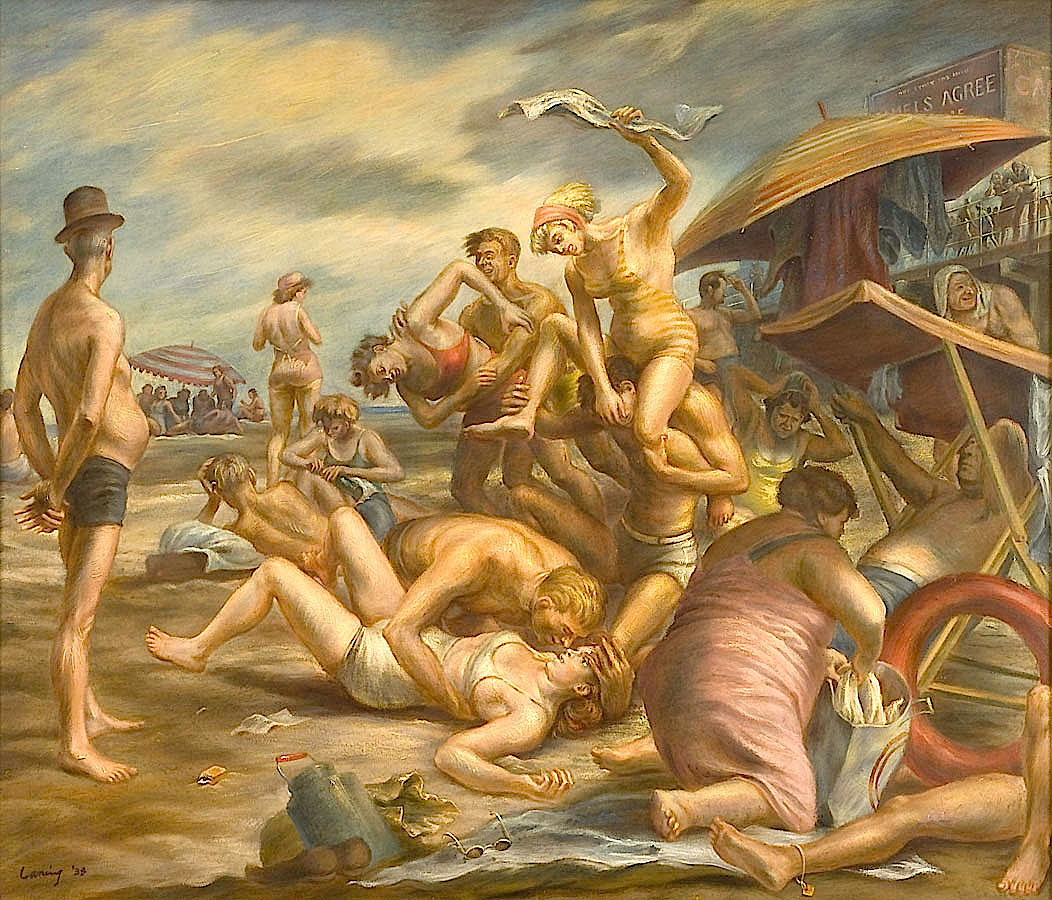
"Coney
Island" by Edward Laning (1938)
IN THIS ISSUE
ONE DAY IN QUÉBEC
By John Mariani
NEW YORK CORNER
TWO TRATTORIAS IN
THE OUTER BOROUGHS
By John Mariani
NOTES FROM THE WINE CELLAR
WHAT I'M DRINKING NOW
By John Mariani
❖❖❖
ONE DAY IN QUÉBEC
By John Mariani

Old Quebec. Photo by Jean-François Bérgeron
I assume that there is
a good deal of competition between the Canadian
cities of Montréal and Québec as to which offers
the most pleasures for the traveler intent on
finding history, architecture, shopping and
dining on a short trip. For
the latter two interests, Montréal surpasses
Québec, but for the first two, I find Québec the
clear winner.
And the delightful part of a visit to
Québec is that its touristic charms can pretty
much be covered in two days, perhaps appended by
visits outside the city to Jacques Cartier
National Park and Le Massif de Charlevoix, which
offer some of the most spectacular mountain
views in North America.
 It is
almost impossible to stand anywhere in Québec and
not gaze upon the towering Château Frontenac (above), which
has dominated the city’s skyline for more than a
century, opened in 1892 by William Van Horne,
general manager of the Canadian Pacific railway,
as a stopover for travelers that have included
King George VI and Queen Elizabeth, Princess Grace
of Monaco, Ronald Reagan, François Mitterrand,
Charles Lindberg, Alfred Hitchcock and Ernest
Hemingway. Its
vast layout is best seen in aerial photos, for it
sprawls atop Dufferin Terrace (left) in full
view of the St. Lawrence River. Just to
stroll through its magnificent wood-carved
hallways and to peak into its splendid Champlain
restaurant is requisite activity.
It is
almost impossible to stand anywhere in Québec and
not gaze upon the towering Château Frontenac (above), which
has dominated the city’s skyline for more than a
century, opened in 1892 by William Van Horne,
general manager of the Canadian Pacific railway,
as a stopover for travelers that have included
King George VI and Queen Elizabeth, Princess Grace
of Monaco, Ronald Reagan, François Mitterrand,
Charles Lindberg, Alfred Hitchcock and Ernest
Hemingway. Its
vast layout is best seen in aerial photos, for it
sprawls atop Dufferin Terrace (left) in full
view of the St. Lawrence River. Just to
stroll through its magnificent wood-carved
hallways and to peak into its splendid Champlain
restaurant is requisite activity.
From the hotel you can wind though Québec’s Old
Town to Place Royal (below), where in 1606 Samuel de
Champlain founded the first French settlement in
North America; the square retains all its 17th and
18th century cobblestone charm, including the
beautiful Notre-Dame-des-Victoires, the oldest
stone church in North America, built in 1688. The
streets and staircases that lead in and out of the
Place are just as historic, some with painted
walls depicting Québec history—especially the Rue
du Petit Champlain.
The streets are dotted with boutiques and
bistros. The
Lower Town, which can be reached by a funicular,
brings you to the foot of Cap Diamant, from where
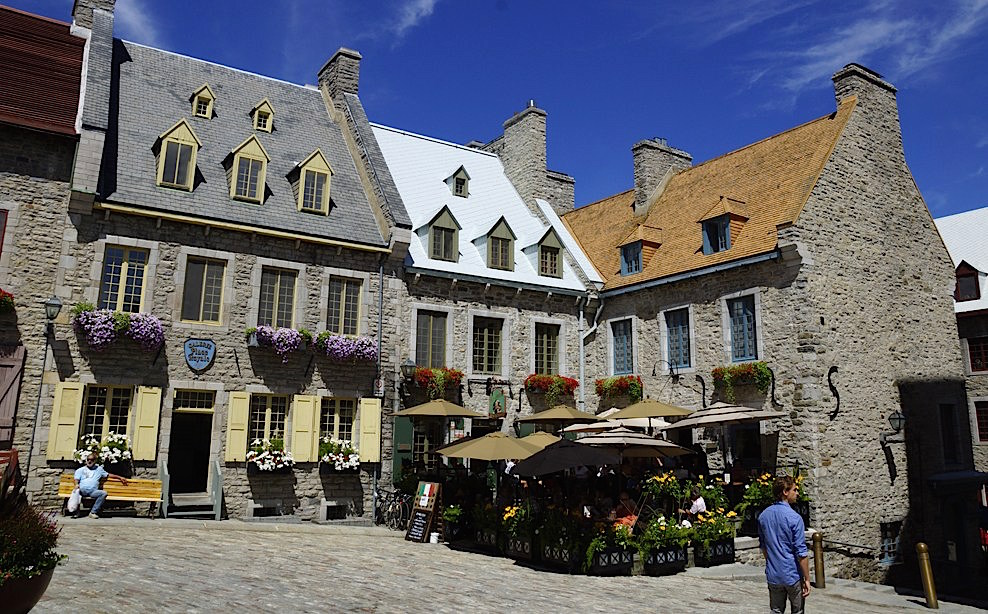 it’s a short walk to
the Old Port.
it’s a short walk to
the Old Port.
Not very far away is the business
and government sector of the city, which includes
the superb Parliament Building (dedicated 1886)
and its 22-foot tall Fontaine de Tourny, with its
43 water jets and sculpted figures—all shipped in
from Bordeaux only in 2003 by department store
magnate Peter Simons. Beyond that are the great
Plains of Abraham, Québec’s beautifully landscaped
240-acre park with the enchanting Joan of Arc
Garden with over 150 plant and flower varieties on
display. The
Plains of Abraham (below) was the site of the
Battle of Québec in 1759, during the Seven Years
War, whose victory by British troops over the
French sealed the city’s future, defenses, and
architecture. In 1763 with the Treaty of Paris the
French lost all claims to Canada, whose effect was
to engage the French to help the Americans against
the British when the Revolutionary War began.

Down in the Old Port is a
three centuries old Auberge Saint-Antoine, now a
wholly modern hotel within the shell of a very
historic property, once used as a wharf, a cannon
battery, and mercantile warehouse, remnants of
which have been preserved in the auberge by four
generations of the Price family from Wales, which
made its fortune in logging. The
auberge is now run by Martha Bate Price (wife of
Tony Price), Evan, Llewellyn and Lucy Price (their
children and the family’s 6th generation).
On a recent visit, my wife and I had the pleasure
of dining at the Auberge’s lovely Panache
restaurant (below),
dating back to 1822 as a warehouse, set within
rustic stone walls with a wood-beamed ceiling and
with a marvelous view of the great river. Young
French Chef Louis Pacquélin’s cuisine is derived
from Canada’s seasons. “I work a lot with fruits
and vegetables in spring and summer from our
organic farm,” he said at lunch, “then focus on
the proteins in winter. I had to work hard to find
the best farmers to supply what I wanted. I am
also impressed with the Canadian artisanal
cheeses.” 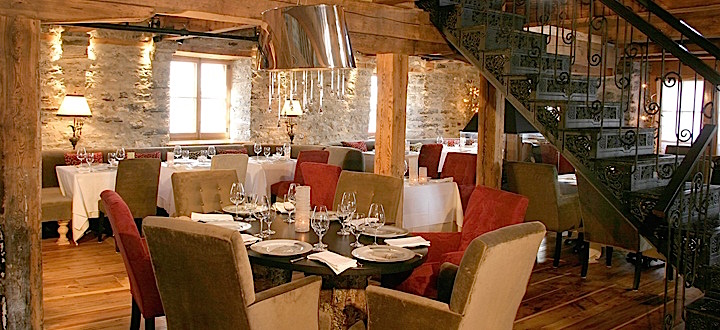
The result is a menu of French and Quebeçois
classics like roast suckling pig with a ragôut of
white beans and sage, spiced with Dijon mustard.
We began with tangy, warm goat’s cheese on
toast with honey and frisée greens that proved
Pacquélin’s point about the quality of Canadian
cheeses. Also,
there was an excellent terrine of chicken livers
with housemade cornichons and croutons, and an
impeccably made chicken soup with truffles in the
style of the Lyonnais restaurant La Mère Brazier.
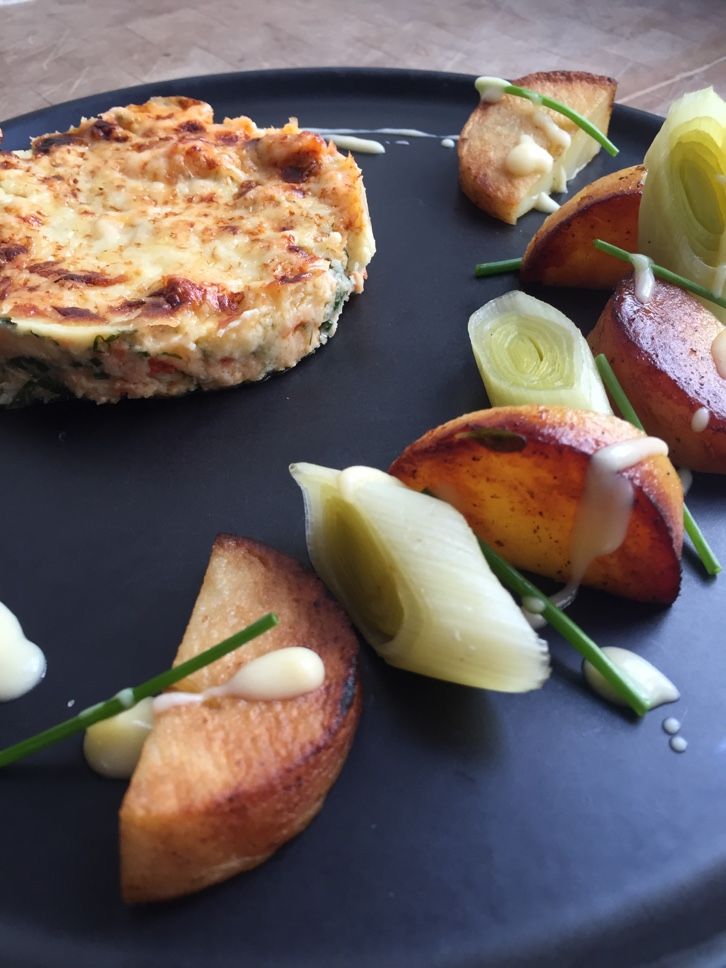 That
juicy, crisp-skinned suckling pig was delicious,
as was a gratin of lobster with very rich, very
proper sauce Mornay, further enriched with a
potato fondant and leeks but a little too much
thyme. Filet
of Canadian beef came within a pastry crust, a
tough thing to make well and here it was very,
very good, the brioche crisp, the beef perfectly
cooked, served with a marmalade of peppers and
salad of green beans. Somewhat lighter was a dish
of ravioli stuffed with butternut squash and
ricotta.
That
juicy, crisp-skinned suckling pig was delicious,
as was a gratin of lobster with very rich, very
proper sauce Mornay, further enriched with a
potato fondant and leeks but a little too much
thyme. Filet
of Canadian beef came within a pastry crust, a
tough thing to make well and here it was very,
very good, the brioche crisp, the beef perfectly
cooked, served with a marmalade of peppers and
salad of green beans. Somewhat lighter was a dish
of ravioli stuffed with butternut squash and
ricotta.
Dessert was deeply satisfying—a classic
chocolate éclair with pear and sugar-butter
crumble. It
was all as fine a meal as I’ve ever had in Canada.
Panache’s wine list holds 700 selections and
12,000 bottles, including several Canadian
bottlings. We
enjoyed a Cuvée Spéciale Vignoble do Marathonien
2012 at a reasonable $45.
Lunch
appetizer & main course or main course &
dessert: $19; Appetizer, main course, dessert
& filter coffee or tea: $24; Dinner $19 prix
fixe or $14-$29 for appetizers, $39-$54 for main
courses.
es.
❖❖❖
By John Mariani
THE OUTER BOROUGHS
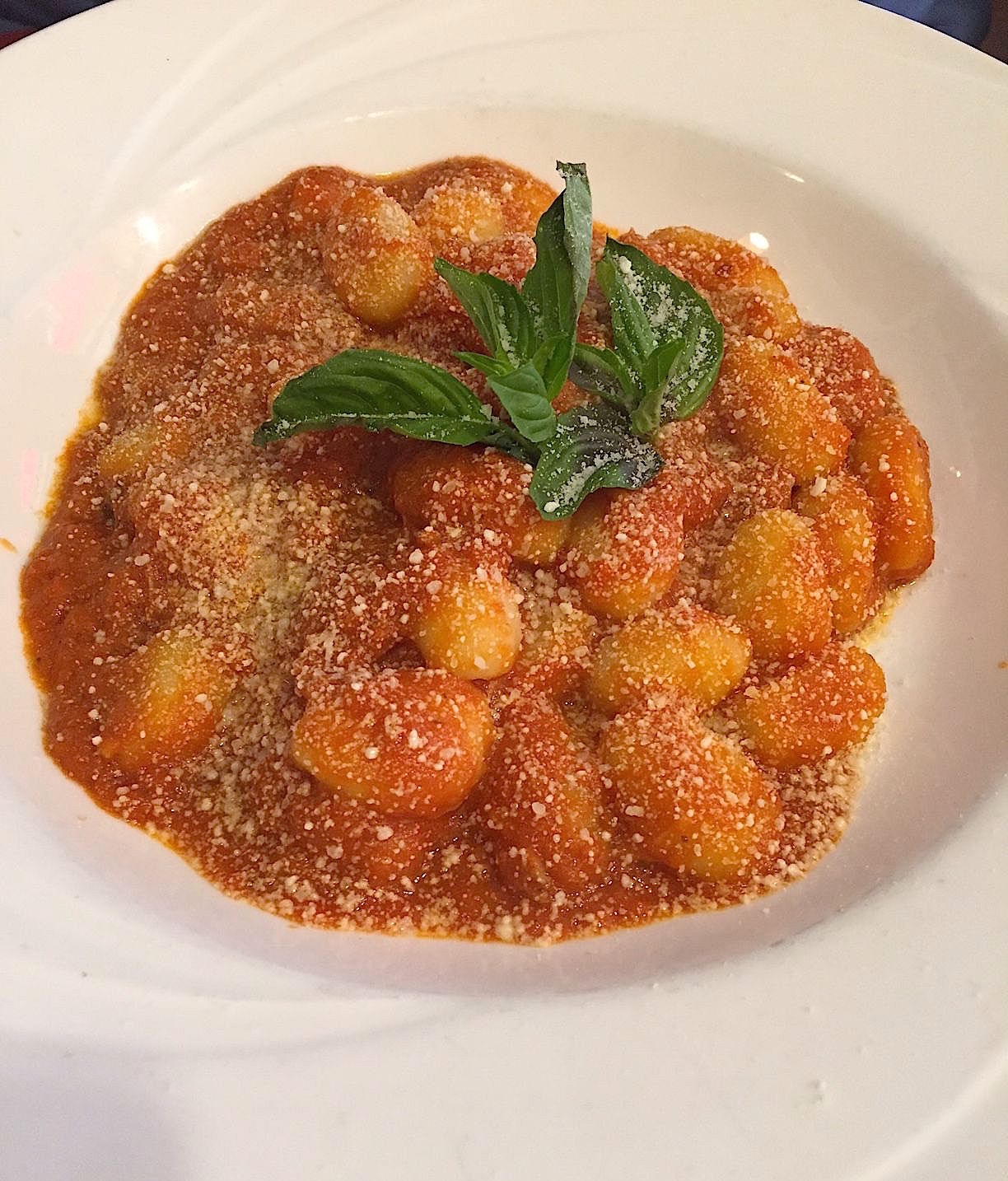
Gnocchi with pork and beef ragù at San Gennaro
Now that the New York food
media have started to run low on Brooklyn
eateries to rave about, there has been
slightly more interest in the once
neglected boroughs of the Bronx and
Queens, both rife with restaurants of
every ethnic stripe, not least good
Italian trattorias without the hour-long
waiting time and the five-dollar slices of
pizza at an over-hyped place like
Brooklyn’s Di Fara Pizza. Here
are two places the mainline media may
someday get around to noticing.
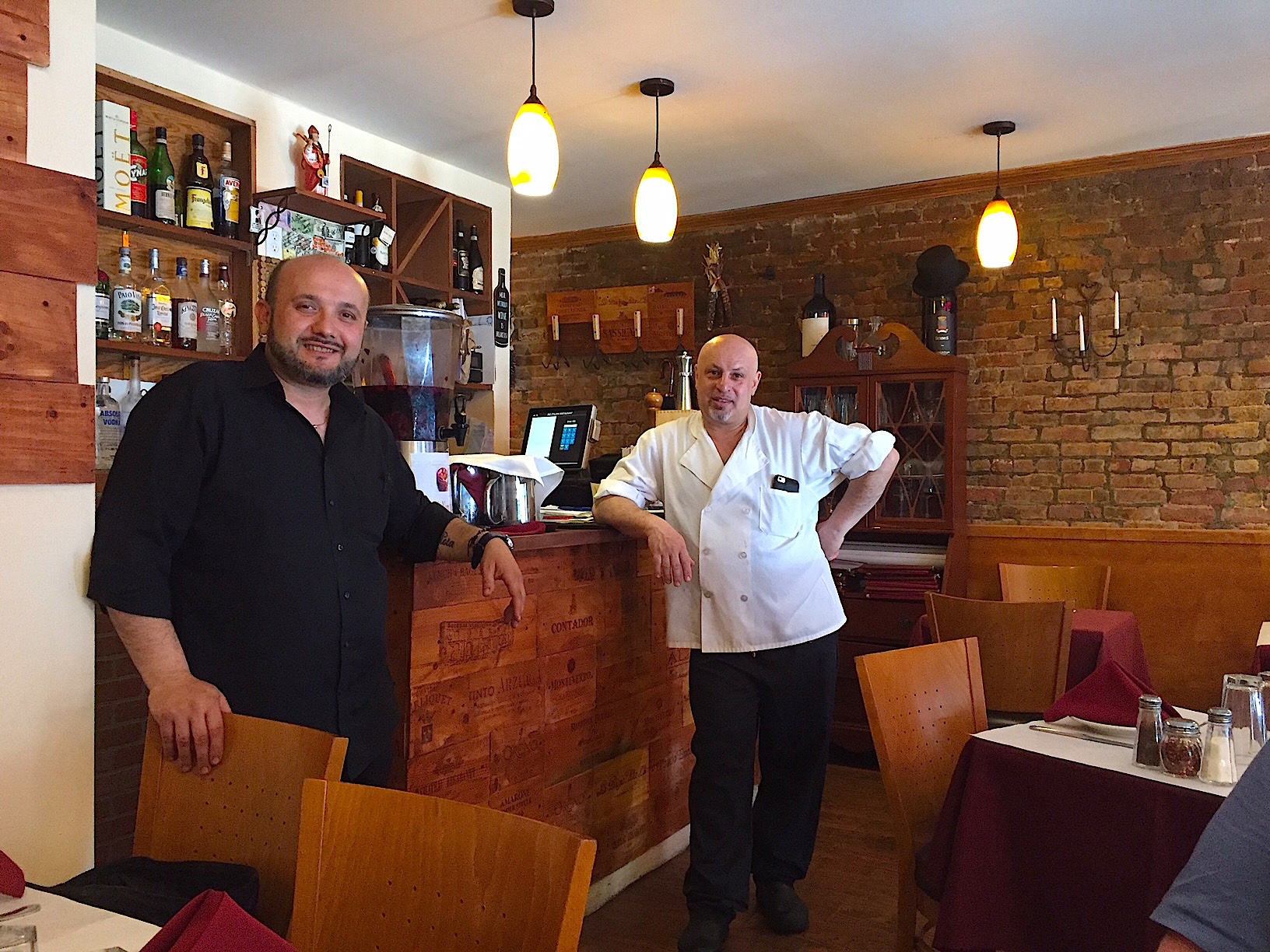 SAN
GENNARO
SAN
GENNARO
2329 Arthur Avenue, Bronx, NY
718-562-0129
http://www.sangennarorestaurant.com
Gennaro Martinelli (left), born
in Capua, south of Naples, has long experience
cooking around the world, from Paris to Bruges,
from Austria to Kenya, from Thailand to Brazil,
so when he took over San Gennaro in the Bronx’s
Little Italy section known as Belmont, you could
tell right away that he was going to cook with
somewhat more refinement than at most of the
established Italian-American places in the
neighborhood.
His expertise, along with that of Chef Giuseppe
Cammarota (left),
shows clearly in the standard dishes of the
genre, from excellent, greaseless, lightly
battered calamaretti
fritti to linguine with vongole
clams in the shell. Pastas are always al dente,
ingredients gleaned from the Arthur Avenue
markets, which means half a dozen specials every
day, among which you’ll find the best dishes on
a long menu.
San
Gennaro is going through some decorous
changes—new floor, new chairs—that will soon
include an inserted wine wall, which I’m told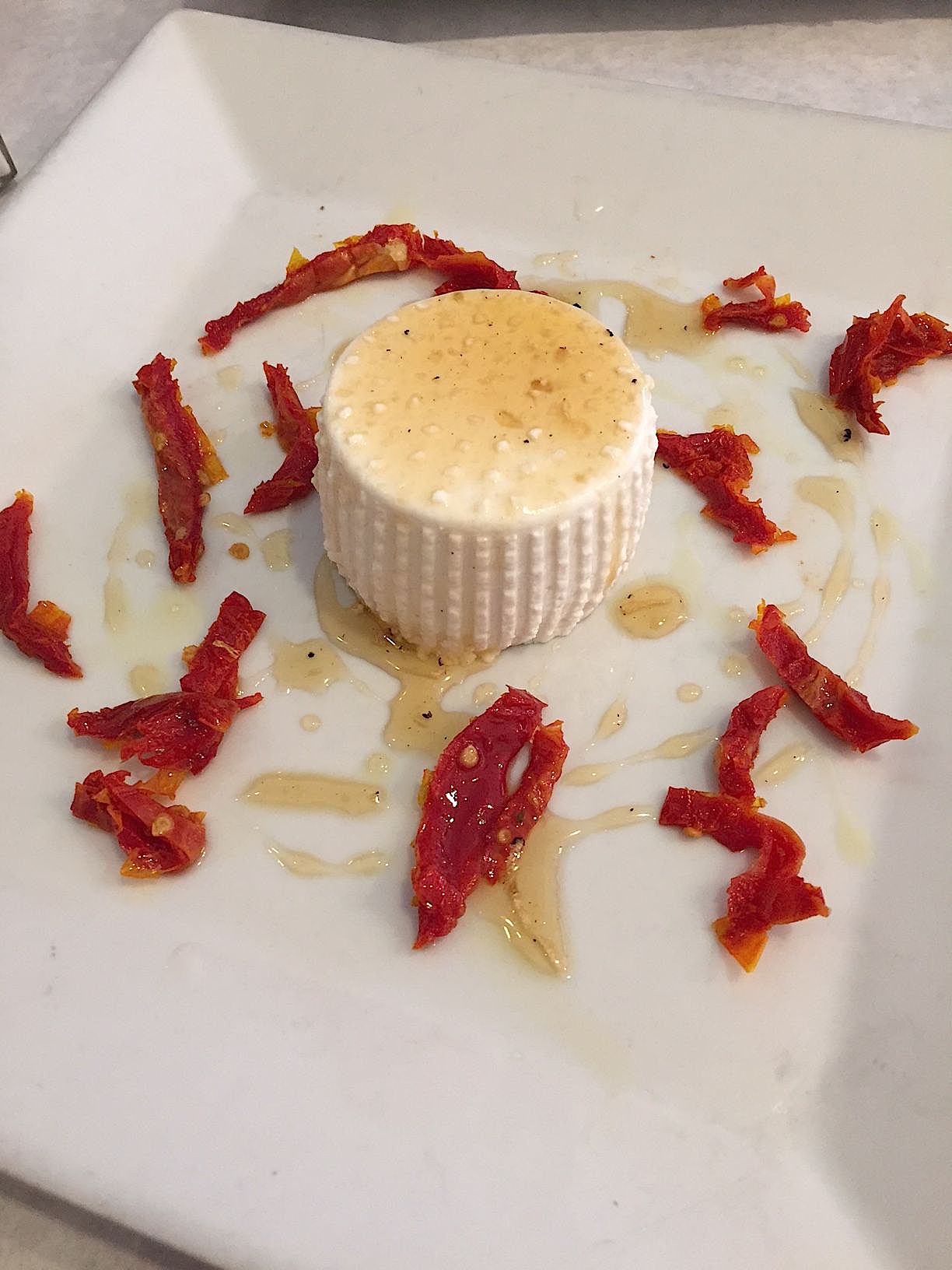 will increase a
wine list in need of more and better selections.
will increase a
wine list in need of more and better selections.
The room is small but it’s
appended with a delightful patio on the street
that is especially sought out in spring and
summer. Tables
are
close to one another, and it’s highly likely
you’ll chat with diners at the next one over,
either recommending what you’re eating or taking
the advice on what they’re enjoying. Everything
that comes out of the kitchen looks wonderful,
and while Martinelli is a very congenial host,
he hires an equally amiable waitstaff.
Antipasti should not be neglected, since
Martinelli may have just obtained some buffalo
ricotta, semi-soft in a lattice pattern (right),
drizzled with truffle honey and ringed with
sun-dried tomatoes ($13). Grilled,
marinated vegetables come glossed with good
olive oil ($11 or $22), and they do a splendid
carpaccio of slightly smoked swordfish ($12);
the same treatment was given pressata di
polpo ($15) as a special last week, and it
was exceptionally delicate octopus, colorful and
tangy with big capers from Pantelleria.
Just about every pasta
I’ve had at San Gennaro has been very, very
good, many housemade, and the fettuccine with
abundant shrimp in a verdant pesto ($18)
is excellent.
Two specials often featured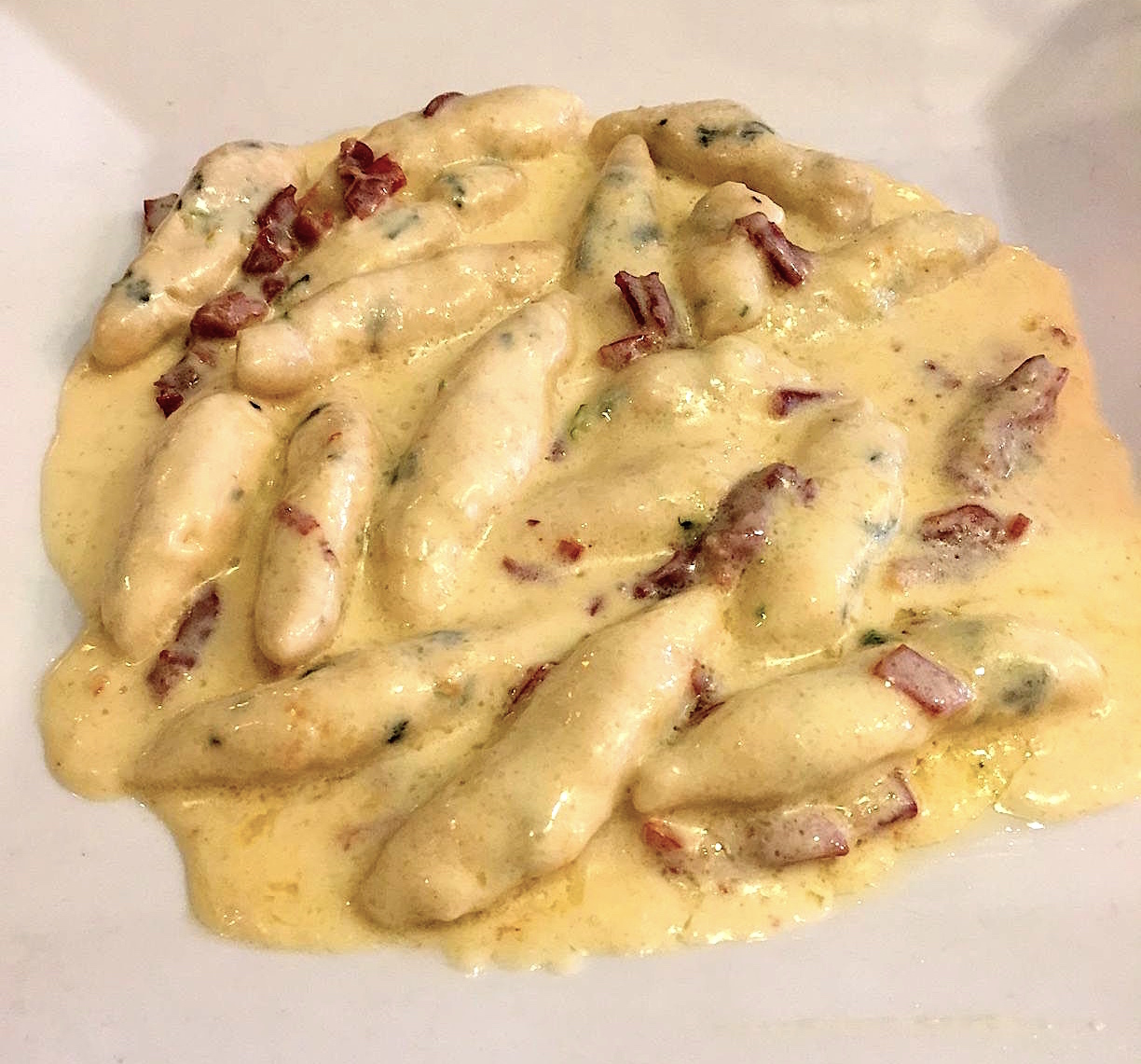 are the nudi (left)
dumplings ($24), made with ricotta and fontina,
spinach, prosciutto and white truffle paste in a
lavish, cheese-rich cream sauce, and perfect
potato gnocchi ($20), airy but substantial, in a
pork and beef ragù cooked slowly for three hours
to incorporate all the flavors and spices.
are the nudi (left)
dumplings ($24), made with ricotta and fontina,
spinach, prosciutto and white truffle paste in a
lavish, cheese-rich cream sauce, and perfect
potato gnocchi ($20), airy but substantial, in a
pork and beef ragù cooked slowly for three hours
to incorporate all the flavors and spices.
My favorite meat dish here is the pollo
scarpariello ($18), big chunks of chicken
cooked in white wine-lemon sauce with hot
vinegar peppers and sweet sausage (ask for it on the
bone). Fillet
of sole is quickly sautéed and served with
vegetables in a white wine-lemon sauce ($22),
and the scaloppini of veal with a dreamy
Gorgonzola sauce takes on nuance from chopped
walnuts ($24).
Last time I had the osso buco
it was disappointingly dry ($30).
By the way, you might save that ricotta
appetizer as a fine dessert, without the
peppers, but the cheesecake made here is one of
the best in the neighborhood ($9).
Gennaro Martinelli is
always at his little trattoria and you’ll get to
know him quickly.
Take his recommendations. It
makes him and Giuseppe very happy if you do.
Open daily for lunch and dinner.
MILKFLOWER
34-12 31st Avenue, Astoria, NY
718-204-1300
Fraternity is among the
strongest of human bonds but, brothers being
brothers, there is also sibling rivalry. Both
may be the case with Jersey boys Peter
and Danny Aggelato, but both are so committed to
their darling pizzeria-trattoria in Astoria—they
are on premises seven days a week—that you will
sense immediately that Milkflower is a
labor of love.
Both men have worked for years in others’
restaurants—Danny in pizzerias, Peter as
manager—but they dreamed of having their own
place in this gentrifying Queens neighborhood of
good ethnic restaurants of every stripe, but
none quite like Milkflower, which refers to the
whole milk called fior di
latte used in Italy to make mozzarella. While
principally a pizzeria in the Neapolitan style,
the long slip of a space with a garden patio out
back makes 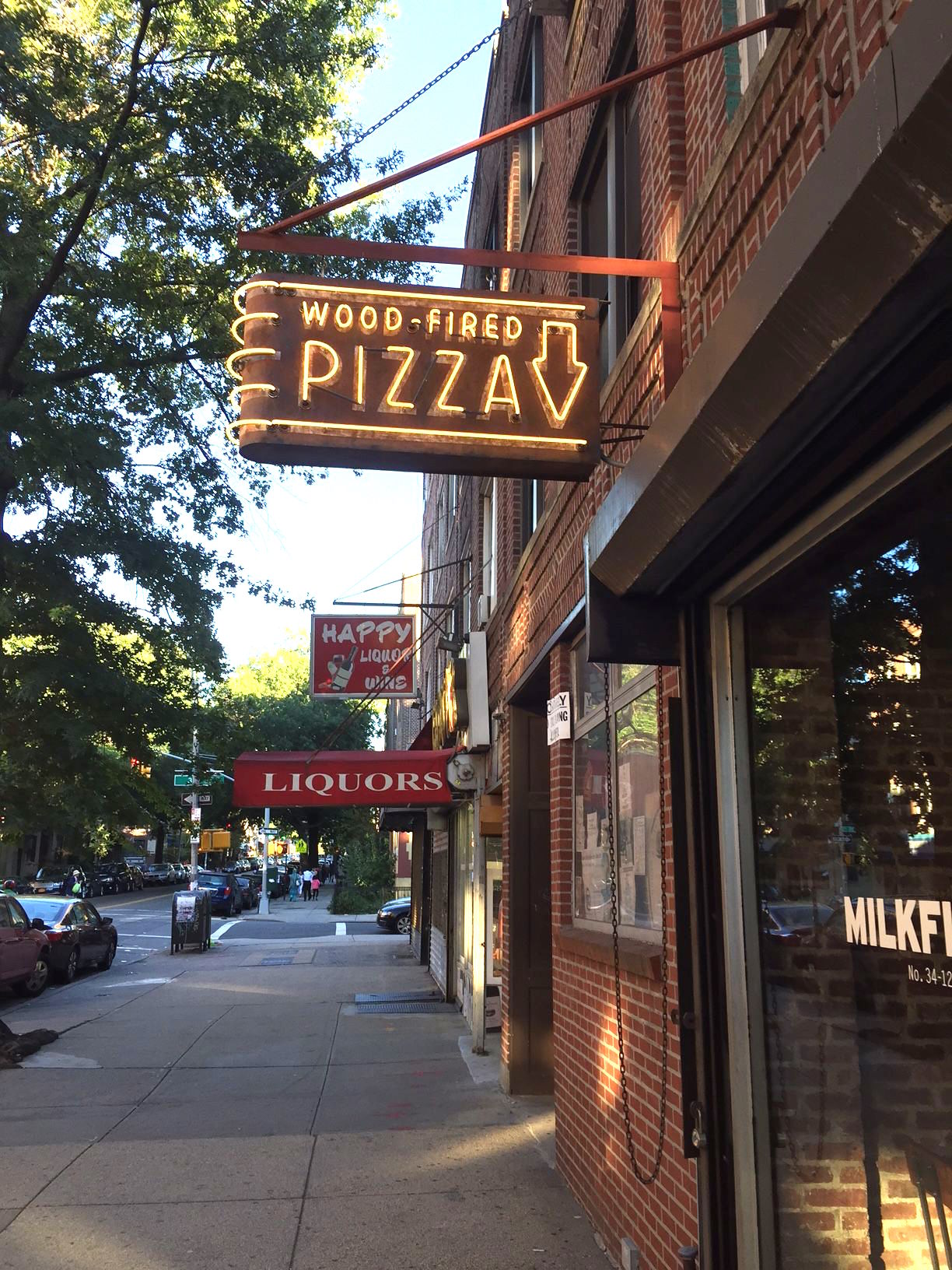 far more use of the wood-burning
oven than usual, resulting in wonderful small
dishes like roasted octopus with potatoes and
green olives graced with dill ($15) and roasted
meatballs with tomato, garlic confit, grana
padano cheese and basil ($11). They
also do a pea toast with a touch of mint and
creamy-rich burrata
and grated lemon ($10). Plates
of Serrano ham ($14), a string bean salad, with
persimmon, feta, almonds and citrus ($11), and
eggplant caponata
($12) made smoky by that oven is enriched with burrata,
pinenuts and a dash of balsamico.
far more use of the wood-burning
oven than usual, resulting in wonderful small
dishes like roasted octopus with potatoes and
green olives graced with dill ($15) and roasted
meatballs with tomato, garlic confit, grana
padano cheese and basil ($11). They
also do a pea toast with a touch of mint and
creamy-rich burrata
and grated lemon ($10). Plates
of Serrano ham ($14), a string bean salad, with
persimmon, feta, almonds and citrus ($11), and
eggplant caponata
($12) made smoky by that oven is enriched with burrata,
pinenuts and a dash of balsamico. 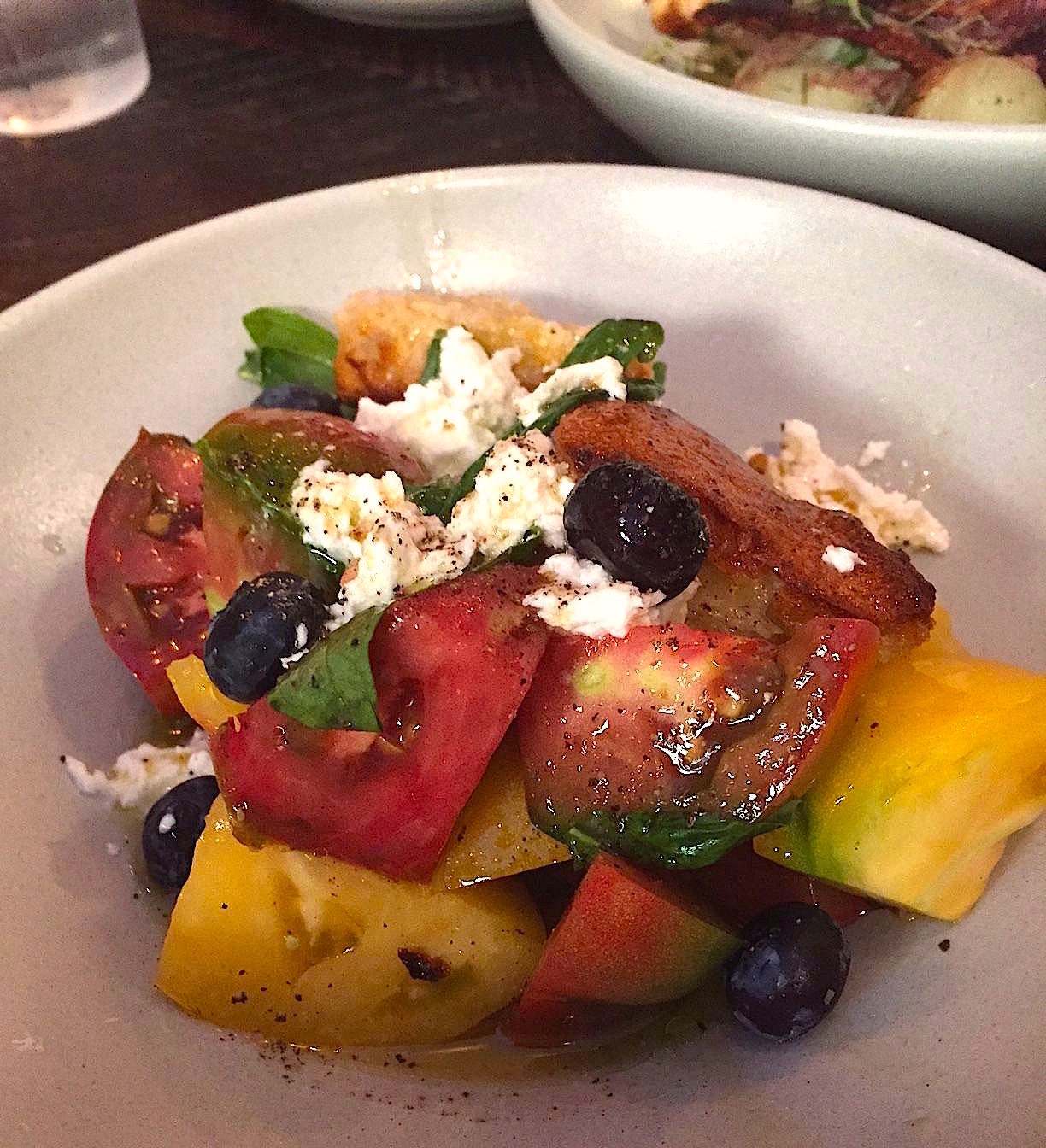
There are also some delectable pasta offerings,
from Roman cacio e
pepe (cheese and pepper) on fat bigoli noodles
($13) and rolled cavatelli
in a beef ragù
with goat’s milk feta ($16).
The Aggelatos can be proud of
all those dishes, but clearly their hearts and
energies are focused on their ever-improving
pizzas, from a classic margherita ($12) to one
called “s.t. the ghost,” named after an
employee, made with Grafton cheddar, mozzarella,
Parmigiano cheese and burnt honey ($15).
These are not the
ultra-crisp flatbread variety of pizzas; they
are the soft-centered Neapolitan variety, always
with a risen corona around the rim, with
blistered bubbles and charcoal scorchings that
make them so marvelous in both lingering flavor
and chewy texture.
Sometimes there’s no reason to re-invent the
wheel, if your goal is just to make a better
wheel, and that’s what the charmingly named
Milkflower is doing to the very best of the
brothers’ abilities.
Open for lunch Sat. & Sun., for
dinner nightly.
❖❖❖
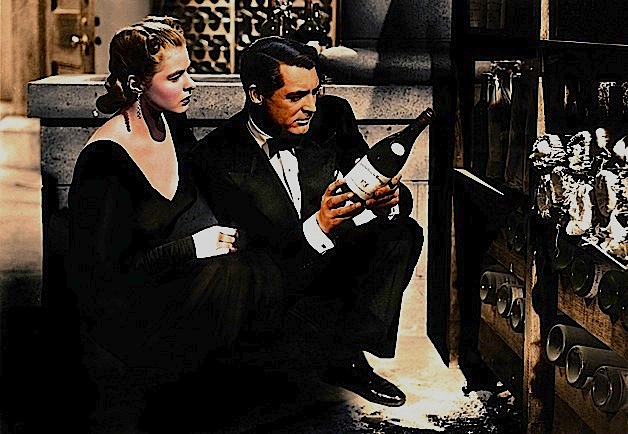
WHAT I'M DRINKING NOW
By John Mariani
I am
in no way doctrinaire about what to drink “in
season,” so while I do look forward to
sampling more rosés and lighter reds with
seafood and chicken, I’m just as happy with a
brawny Cabernet or Zinfandel with my grilled
red meats.
Here are several wines I’ve been
delighted with recently.
Cleto Chiarli Brut de Noir Rosé ($15)—A
delightful medium-bodied spumante rosato from
a very modern winery outside of Modena, Italy,
better known for its Lambrusco. It’s a
blend of Grasparossa and Pinot Nero, at 12%
alcohol, so it goes down very easily. I find it
a perfect aperitif—at a great price—that can
carry over into first courses like shrimp
grilled or in a salad.
Lambrusco. It’s a
blend of Grasparossa and Pinot Nero, at 12%
alcohol, so it goes down very easily. I find it
a perfect aperitif—at a great price—that can
carry over into first courses like shrimp
grilled or in a salad.
Clos de Capelune Cru Classe Côtes de
Provence 2015 ($16)—Produced by Château
Saint-Maur, this is a fuller bodied rose with
13% alcohol that distinguishes a Cru Classe,
with wonderful aromatics and flowers in the
bouquet and enough heft to go very well with
anything but grilled red meats. It is
a blend of Grenache,
Cinsault, Mourvèdre and Rolle.
Mercer Horse Heaven
Hills Sharp Sisters Red Blend 2013
($20-$26)—The blend of 47% Merlot, 41% Syrah,
and 16% other grapes, with 20 months aging, gives
this the fruit and the mellowness, and its
moderate heft made it a wonderful accompaniment
to black bean soup and suckling pig cooked on
the grill.
Cobb Pinot Noir Rice-Spivak
Vineyard 2013 ($75)—With just
12.8% alcohol, this is a lightweight Pinot Noir
with plenty of
bright fruit flavors. Winemaker
Ross Cobb picks his grapes at a lower Brix level
than many others do in Sonoma, and he tones down
the use of oak. The grapes come from cool
climate vineyards around Sebastopol with lots of
volcanic ash and it reminds me of lighter style
red Burgundies that go so well with wild salmon
in summer. The price is up there, though.
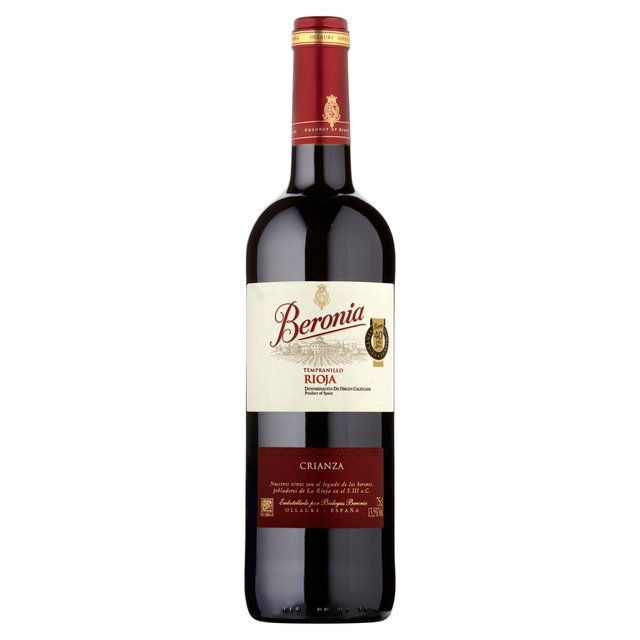 Beronia Rioja
Crianza 2012 ($13-$14)—A superb example
of the Crianza style of Rioja, which ranks just
above basic Rioja, spending one year in oak and
one in bottle, emerging with a very reasonable
13.5% alcohol from 88% Tempranillo, 10%
Guarnacha, and 2% Mazuelo (the Spanish name for
Carignan), which provides a nice acidity. Most
Crianzas are in this price range, making them
excellent with just about anything on the summer
table.
Beronia Rioja
Crianza 2012 ($13-$14)—A superb example
of the Crianza style of Rioja, which ranks just
above basic Rioja, spending one year in oak and
one in bottle, emerging with a very reasonable
13.5% alcohol from 88% Tempranillo, 10%
Guarnacha, and 2% Mazuelo (the Spanish name for
Carignan), which provides a nice acidity. Most
Crianzas are in this price range, making them
excellent with just about anything on the summer
table.
Il Tascante Nerello Mascalese IGT 2011 ($50)—At
this price this might be a tough sell for a
Sicilian wine, but it shows the direction the
best wineries are taking to modify the too-often
too-huge body of others in its category. It is
a lighter, more supple version of Nerello
Mascalese,
grown on the northern slopes in Mt.
Etna’s volcanic soil, with 13.5% alcohol. It
puts me in mind of some Tuscan IGT reds (the
grape may be an offshoot of Sangiovese), and
would be a fine accompaniment to grilled chicken
or lamb.
Spottiswoode Sauvignon Blanc 2014
($32-$34)—I’m no fan of flowery, sweet Sauvignon
Blancs, but Spottiswoode avoids tipping into
that popular style. It’s a bit drier and lacks
that overly grassy component you often find in
Napa Valley Sauvignon Blancs, achieving a better
balance of fruit and acid that makes it a good
choice for any kind of summer’s seafood,
especially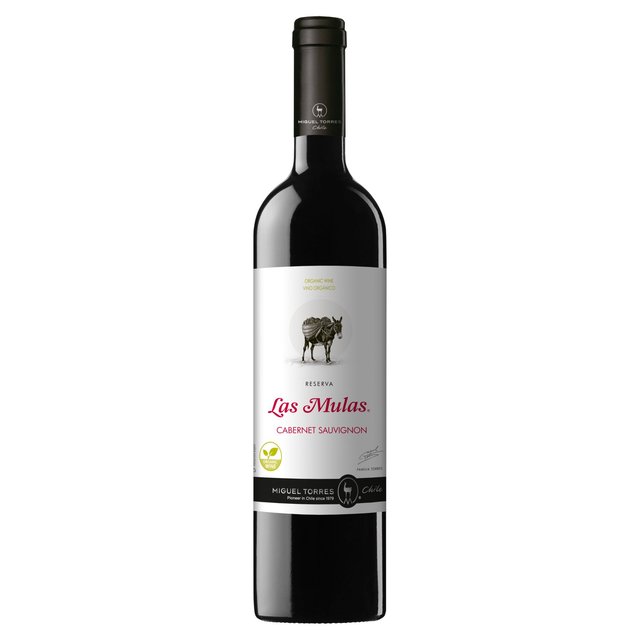 blue fish.
blue fish.
Miguel Torres Las
Mulas Reserva Cabernet Sauvignon 2014 ($10-$14)—A
terrific price for an impeccably made Cab from
Central Valley, Chile. The grapes are from
organic vineyards (begun in 1979 by the Torres
family), the alcohol is a fine 13.5%, and yet,
despite being 100% Cab, there are layers of
flavor and the texture is just right, with the
tannins already toned down. Very
good wine with any red meats.
Château Tourril
Cuvée Helios Minervois 2015 ($10)—What
a little enchanter! This Provençal 100% Roussane
is made by two friends who have aimed at and
achieved a wine at 13% alcohol with a
substantial taste profile that profits from the
sunny South of France, emphasizing aromatics,
along with fruit and subdued sweetness. With
sushi and sashimi it works very well, as with
just about all seafood, not least scallops and
lobster. You
can’t beat the price.
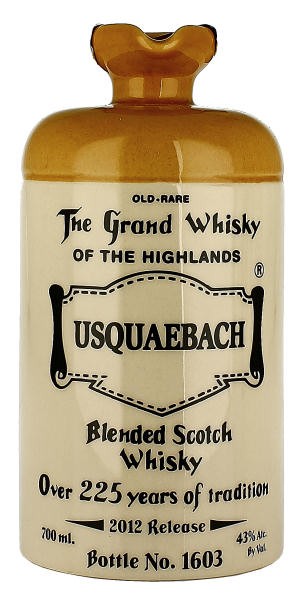
Usquebach Old Rare
Superior Blend ($115)—This would make a
capital Father’s Day gift for its flagon bottle,
but at $115 there’d better be a fine Scotch
inside. And
there is, blended by the Laing family from 41
whiskies with a good dose of malt in the making.
It has just enough bite balanced with
smoothness, and the sherry-like finish is a
bonus. There
is also a Reserve Premium Blend at $40 and
15-year-old Pure Blended Malt at $80.
Canadian Club 100% Rye
($19.99)--The resurgence of interest in rye,
once a staple of every bar and home 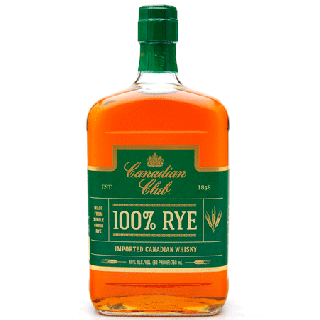 spirits cabinet, has
resulted in the usual overpriced novelties in
the market, most drawn from the same stocks as
the next bottle over. So you figure that
Canadian Club, which has been around since 1858,
knows a bit more about the nuances of 100% rye
(by law a bottle labeled rye need only be 51%
rye), this good-looking bottling at 80 proof,
made from Calgary grain, without barley or corn.
And while it makes a classic mixer for
cocktails, this new offering has a lot of spice,
richness, and true rye flavor with just enough
burn to sip on the rock or with a dash of water.
spirits cabinet, has
resulted in the usual overpriced novelties in
the market, most drawn from the same stocks as
the next bottle over. So you figure that
Canadian Club, which has been around since 1858,
knows a bit more about the nuances of 100% rye
(by law a bottle labeled rye need only be 51%
rye), this good-looking bottling at 80 proof,
made from Calgary grain, without barley or corn.
And while it makes a classic mixer for
cocktails, this new offering has a lot of spice,
richness, and true rye flavor with just enough
burn to sip on the rock or with a dash of water.
❖❖❖
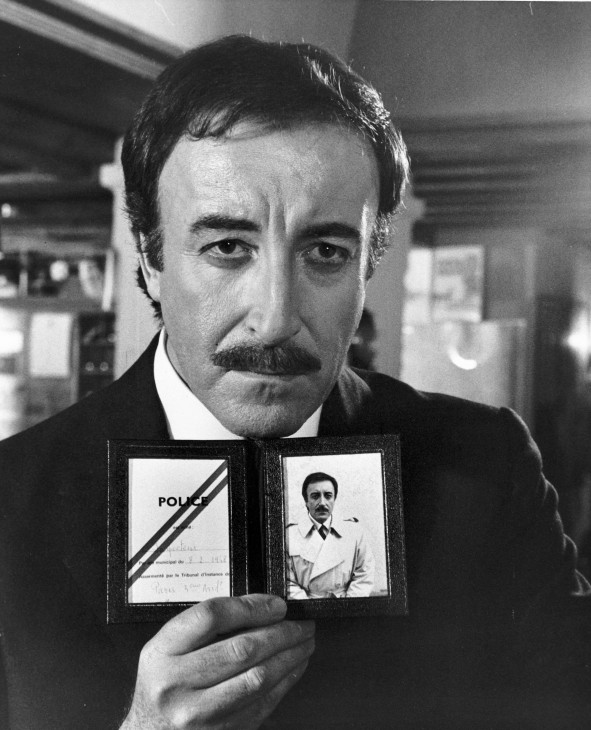 AND ASKING,
"YOU GUYS SERVE AMERICAN COFFEE
AND ASKING,
"YOU GUYS SERVE AMERICAN COFFEE
IN THIS JOINT?" WILL GET YOU DEPORTED
Cafés in France have begun adding charges to their menus
for rude behavior. L'Hamburgé in Grenoble lists
coffee prices that range from €1.50 (for barbarians)
down to €1 (for nice, polite customers). At La Petite
Syrah in Nice, they charge €7 if the customer
simply demands, "Coffee," but €4.25 if the person says,
"A coffee, please," and €1.40 if ordered with a "Hello,
a coffee, please."
DEAR KEVIN,
THANKS FOR INVITING
US TO DINE OUT WITH YOU,
BUT, Y'KNOW WHAT? LOOKS
LIKE WE'RE BOOKED UP FOR
THE REST OF OUR LIVES.
“I tend to rank
delis on an indigestion scale, one being hardly worth a
belch while five is a full-on gaseous bloat with
accompanying salami-based halitosis.”—J. Kevin Wolfe,
“You Rascal,” Cincinnati
Magazine (April 2016).
By
John Fodera, Tuscan
Vines
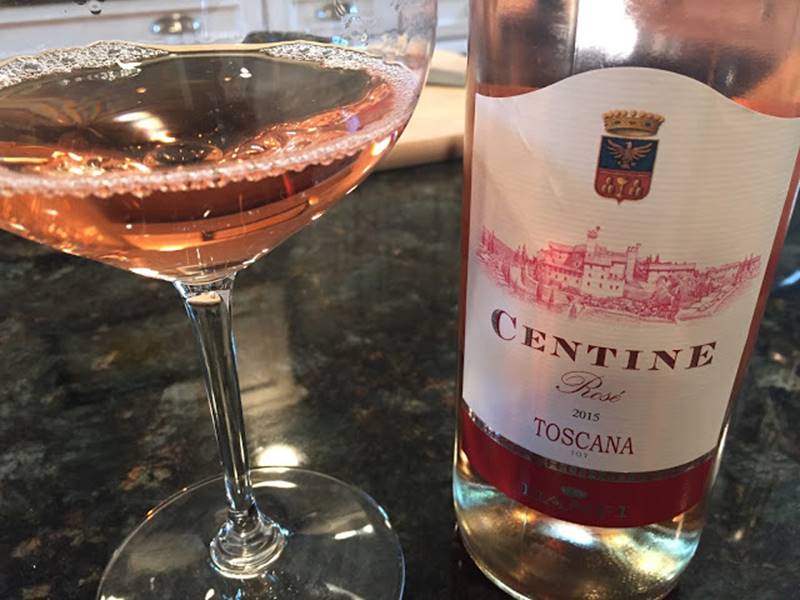 Finally...finalmente! Some sun and warmer weather
finally arrived this week and we at Tuscan Vines were
more than happy to get outside, stroll the garden and
sip a lovely, refreshing rosé.
Finally...finalmente! Some sun and warmer weather
finally arrived this week and we at Tuscan Vines were
more than happy to get outside, stroll the garden and
sip a lovely, refreshing rosé.
I think Rose is still a difficult
wine for many, especially Americans, to appreciate. Spoiled by the sappy, cloying
nature of so many White Zinfandels, people often
incorrectly assume that roses are sweet wines that don't
really have a place at the table. The
truth couldn't be further from that supposition and the
pink wines I like best are typically the versions that
are steely and dry. That
brings me to Centine Rosé.
I buy a few bottles of the Centine
Rosé every year. I enjoy it
alone, as an aperitif while I'm cooking.
I enjoy it sitting in the garden and with lighter
dishes like this Panzanella or these antipasti. My point is, this is versatile
and tasty and incredibly budget friendly.
Today we're talking about the 2015 Centine
Rosé - a wine that comes 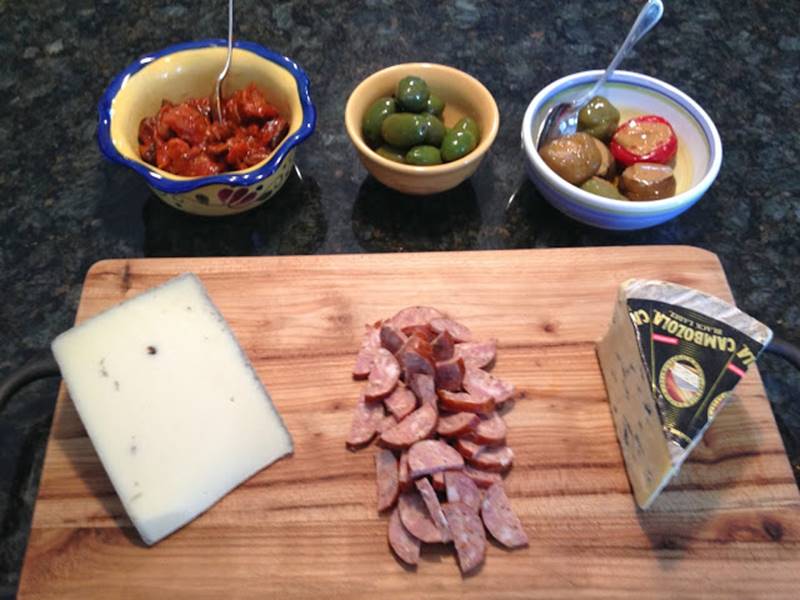 from the next excellent
Tuscan vintage and one that I think is the best example
of this particular wine that I've tried.
from the next excellent
Tuscan vintage and one that I think is the best example
of this particular wine that I've tried.
In the glass, the 2015 Castello Banfi
Centine Rosé is
a bright melon color - it's pink with a sort of orange
reflection throughout.
Like a fading summer sunset. The aromas
from the glass exude watermelon, strawberry, melon and
white flowers. It's more complex than I remember past
vintages being.
On the palate the wine is
exceptionally fresh and vibrant - the vinous version of
Saltimbocca if ever there was one. Bright melon,
strawberry, and mineral tones permeate the palate
throughout and the acidity is refreshing. An unspecified
blend of Sangiovese, Merlot and Cabernet, I suspect the
first grape is the dominant portion of the blend. Serving
temperature is important here, so be cognizant of that
and you will enjoy.
Any of John Mariani's books below may be ordered from amazon.com.
 The
Hound in Heaven (21st Century Lion Books)
is a novella, and for anyone who loves dogs,
Christmas, romance, inspiration, even the supernatural, I
hope you'll find this to be a treasured favorite.
The story concerns how, after a New England teacher,
his wife and their two daughters adopt a stray puppy found
in their barn in northern Maine, their lives seem full of
promise. But when tragedy strikes, their wonderful dog
Lazarus and the spirit of Christmas are the only things
that may bring his master back from the edge of
despair.
The
Hound in Heaven (21st Century Lion Books)
is a novella, and for anyone who loves dogs,
Christmas, romance, inspiration, even the supernatural, I
hope you'll find this to be a treasured favorite.
The story concerns how, after a New England teacher,
his wife and their two daughters adopt a stray puppy found
in their barn in northern Maine, their lives seem full of
promise. But when tragedy strikes, their wonderful dog
Lazarus and the spirit of Christmas are the only things
that may bring his master back from the edge of
despair. WATCH THE VIDEO!
“What a huge surprise turn this story took! I was completely stunned! I truly enjoyed this book and its message.” – Actress Ali MacGraw
“He had me at Page One. The amount of heart, human insight, soul searching, and deft literary strength that John Mariani pours into this airtight novella is vertigo-inducing. Perhaps ‘wow’ would be the best comment.” – James Dalessandro, author of Bohemian Heart and 1906.
“John Mariani’s Hound in Heaven starts with a well-painted portrayal of an American family, along with the requisite dog. A surprise event flips the action of the novel and captures us for a voyage leading to a hopeful and heart-warming message. A page turning, one sitting read, it’s the perfect antidote for the winter and promotion of holiday celebration.” – Ann Pearlman, author of The Christmas Cookie Club and A Gift for my Sister.
“John Mariani’s concise, achingly beautiful novella pulls a literary rabbit out of a hat – a mash-up of the cosmic and the intimate, the tragic and the heart-warming – a Christmas tale for all ages, and all faiths. Read it to your children, read it to yourself… but read it. Early and often. Highly recommended.” – Jay Bonansinga, New York Times bestselling author of Pinkerton’s War, The Sinking of The Eastland, and The Walking Dead: The Road To Woodbury.
“Amazing things happen when you open your heart to an animal. The Hound in Heaven delivers a powerful story of healing that is forged in the spiritual relationship between a man and his best friend. The book brings a message of hope that can enrich our images of family, love, and loss.” – Dr. Barbara Royal, author of The Royal Treatment.
 |
The Encyclopedia of American Food and Drink by John F. Mariani (Bloomsbury USA, $35) Modesty forbids me to praise my own new book, but let me proudly say that it is an extensive revision of the 4th edition that appeared more than a decade ago, before locavores, molecular cuisine, modernist cuisine, the Food Network and so much more, now included. Word origins have been completely updated, as have per capita consumption and production stats. Most important, for the first time since publication in the 1980s, the book includes more than 100 biographies of Americans who have changed the way we cook, eat and drink -- from Fannie Farmer and Julia Child to Robert Mondavi and Thomas Keller. "This book is amazing! It has entries for everything from `abalone' to `zwieback,' plus more than 500 recipes for classic American dishes and drinks."--Devra First, The Boston Globe. "Much needed in any kitchen library."--Bon Appetit. |
"Eating Italian will never be the same after reading John Mariani's entertaining and savory gastronomical history of the cuisine of Italy and how it won over appetites worldwide. . . . This book is such a tasteful narrative that it will literally make you hungry for Italian food and arouse your appetite for gastronomical history."--Don Oldenburg, USA Today. "Italian
restaurants--some good, some glitzy--far
outnumber their French rivals. Many of
these establishments are zestfully described
in How Italian Food Conquered the World, an
entertaining and fact-filled chronicle by
food-and-wine correspondent John F.
Mariani."--Aram Bakshian Jr., Wall Street
Journal.
"Equal parts
history, sociology, gastronomy, and just
plain fun, How Italian Food Conquered the
World tells the captivating and delicious
story of the (let's face it) everybody's
favorite cuisine with clarity, verve and
more than one surprise."--Colman Andrews,
editorial director of The Daily
Meal.com. "A fantastic and fascinating
read, covering everything from the influence
of Venice's spice trade to the impact of
Italian immigrants in America and the
evolution of alta cucina. This book will
serve as a terrific resource to anyone
interested in the real story of Italian
food."--Mary Ann Esposito, host of PBS-TV's
Ciao
Italia. "John Mariani has written the
definitive history of how Italians won their
way into our hearts, minds, and
stomachs. It's a story of pleasure over
pomp and taste over technique."--Danny Meyer,
owner of NYC restaurants Union Square
Cafe, The Modern, and Maialino.
|
 |
 |
 |
 |
 |
 |
 |
 |
 Everett Potter's Travel Report:
Everett Potter's Travel Report: 
 Eating Las
Vegas JOHN CURTAS has been covering
the Las Vegas food and restaurant scene
since 1995. He is the co-author of EATING LAS
VEGAS – The 50 Essential Restaurants (the
fourth edition of which will be published in
early 2016), as well as the author of the Eating Las
Vegas web site: www.eatinglasvegas.
He can also be seen every Friday morning as
the “resident foodie” for Wake Up With the
Wagners on KSNV TV (NBC) Channel 3 in
Las Vegas.
Eating Las
Vegas JOHN CURTAS has been covering
the Las Vegas food and restaurant scene
since 1995. He is the co-author of EATING LAS
VEGAS – The 50 Essential Restaurants (the
fourth edition of which will be published in
early 2016), as well as the author of the Eating Las
Vegas web site: www.eatinglasvegas.
He can also be seen every Friday morning as
the “resident foodie” for Wake Up With the
Wagners on KSNV TV (NBC) Channel 3 in
Las Vegas.

MARIANI'S VIRTUAL GOURMET
NEWSLETTER is published weekly. Editor/Publisher: John
Mariani.
Editor: Walter Bagley. Contributing Writers: Christopher Mariani,
Robert Mariani, Misha
Mariani,
John A. Curtas, Edward Brivio, Mort Hochstein,
Andrew Chalk, Dotty Griffith and Brian Freedman. Contributing
Photographers: Galina Dargery, Bobby
Pirillo. Technical Advisor: Gerry McLoughlin.
To un-subscribe from this newsletter,click here.
© copyright John Mariani 2016

